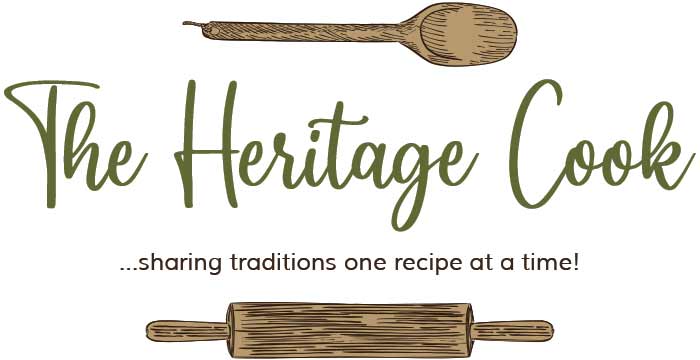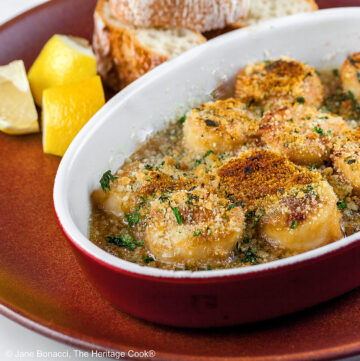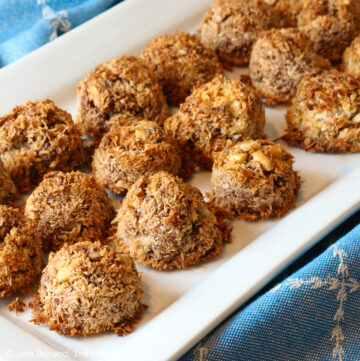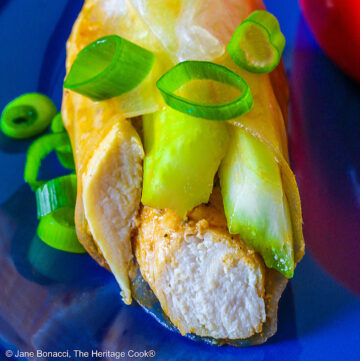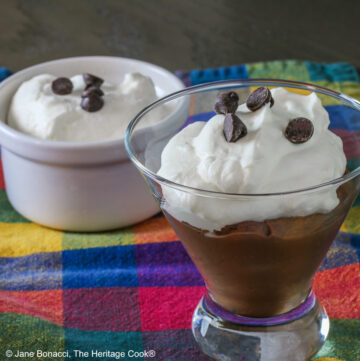My chocolate has gray streaks. It is okay to use?
That’s called ‘bloom’ and it happens when the chocolate melts or gets warm, and then cools again without being tempered. When you buy chocolate, it is already tempered. However if it’s exposed to heat or melted, it can fall out of temper. (You can read my instructions for how to temper chocolate.)
Those streaks that you see is harmless cocoa fat rising to the surface because when the chocolate was warmed, it lost its emulsion (like chicken stock or vinaigrette separates when heated, then cooled.) Similarly, if there are crystal-like formations on the surface, those indicate ‘sugar bloom’ and the chocolate is safe to use. In either case, the chocolate can be melted and used as normal.
If there is green mold, or anything furry, that means the chocolate got damp. In that case, it should be tossed.
How long does chocolate last?
Contrary to what you may hear, dark chocolate lasts around five years. That’s in part due to the high amount of antioxidants, as well as the sugar, which is a preservative.
Milk chocolate and white chocolate contain milk solids and should be used within a year.
What’s the difference between bittersweet and semisweet chocolate?
Technically nothing. Both chocolates must contain a minimum of 35% cacao solids in the US. Some manufacturers that make both will often call their sweeter chocolate ‘semisweet’, although it’s totally arbitrary and they can be used interchangeably in recipes.
What’s the difference between bitter and bittersweet chocolate?
Bitter chocolate contains no sugar, and is often called ‘unsweetened’ chocolate. In some countries it’s called 100% cacao since it’s composed only of ground up cocoa bean mass. Because bitter chocolate has no sugar and no added fat (cocoa beans are about half fat), it is more stubborn to melt and may be slightly grainy in custard and ice cream recipes. Often this can be mitigated by whirling the mixture in an electric mixer before cooking or churning it.
Why does chocolate and liquid melted together become grainy?
Chocolate is an emulsion, which means when you add something to it, and heat it, you break that emulsion. When melting chocolate, make sure you have at least 1 part liquid to 4 parts chocolate. So if you have 1 ounce of water and melt it with 8 ounces of chocolate, that won’t work and you’ll end up with a seized, grainy mass. You need at least 2 ounces of liquid for 8 ounces of chocolate.
Pure oil, such as peppermint or essential oils, can be added to chocolate in any quantity since the oil doesn’t break the emulsion like water or other liquids do.
Can I use chocolate chips for melting in a recipe?
Most commercial-brands of chocolate chips are made of ‘baking resistant’ chocolate, fabricated with less cocoa butter than standard chocolate so they keep their shape when heated. (Think of classic chocolate chip cookies with clearly discernible chips.) If you melt them, you’ll often end up with a sludgy, thick pool of chocolate rather than one that’s smooth.
Some recipes, however, may specifically call for melting chips and although I can’t vouch for every recipe out there, I advise people to follow the author’s advice. Also there are now many chocolate chips that are made from premium-quality chocolate, such as those from Ghirardelli and Scharffen Berger, which can be used for melting as well as baking in cookies.
What is the best chocolate?
That is a tough question. Like anything edible, many things come into play. Do you like bitter chocolate? Or one that is sweeter? Do you prefer a roasted flavor? Or one that is softer, and creamier?
I tell people that the best chocolate is the one that tastes best to them. So I encourage folks to taste as many chocolates as they can, and choose one they like best.
What country makes the best chocolate?
Like the previous question, that’s very tough to say. Almost all cocoa beans are grown close to the equator, and then shipped for processing, so there is nothing geographically advantageous if they’re processed in America, Belgium, France, or Switzerland. Most of the quality of the finished chocolate comes from the quality of the raw beans, their fermentation, then the roasting, grinding, and mixing at the factory.
I should only bake with top-quality, very expensive chocolate. Right?
When you melt chocolate and add it to a batter, such as for brownies or cookies, the finer points of an expensive chocolate may get lost. And while those fancy chocolates may be excellent for nibbling, I’m not sure if using an extremely pricey or rare chocolate is best of baking. I recommend sticking with a middle-range chocolate for baking.
Similarly, many of the new high-percentage chocolate, boasting cocoa contents of 70% and above are very acid and can cause creams and ganaches to break. So I recommend following the advice in the recipe, or using a dark chocolate in the 35-64% range, for best results.
I can’t get, or can’t afford, good chocolate. Any tips?
To boost the flavor of chocolate, you can add 1 teaspoon of instant coffee powder to the recipe. The roasted flavor helps improve and highlight the flavor of the chocolate.
I also like to use chocolate extract, and add a dash to recipes along with vanilla extract (or in place of) in recipes. Some of the ‘top notes’ of flavor are lost when cocoa beans are processed, and chocolate extract replaces many of them. It’s a secret used by some manufacturers, and one whiff from the bottle is enough to convince you that it’s a secret worth sharing.
Can I use drinking cocoa or ground in a recipe that calls for cocoa powder?
Nope. Both drinking cocoa and ground chocolate are formulated with sugar and sometimes other ingredients, since they’re meant for beverages, not baking.
When a recipe calls for unsweetened cocoa powder, do not substitute anything else.
What’s the difference between Dutch-Process cocoa powder and natural? And can they be interchanged?
Dutch-process cocoa means that the beans have been acid-neutralized, which tames the flavor and makes the cocoa darker as well. Many recipes that call for baking powder call for Dutch-process cocoa. Recipes that use baking soda will often call for ‘natural’ (or non-alkalized) cocoa powder. One should not switch one for the other. If you’re unsure of whether your cocoa powder is natural or not, a look at the ingredients will reveal if there is potassium bromate or carbonate in it, an indication it’s been ‘Dutched’.
In Europe, virtually all the cocoa powder is ‘Dutched’, whereas in America, both kinds are widely available. Companies like Hershey’s, Nestlé, Ghirardelli, and Guittard make natural cocoa, and Askinosie, a bean-to-bar chocolate maker, produces a ‘natural’ cocoa powder as well.
Hershey’s makes a Dutch-process blend cocoa which is extremely dark (think Oreo cookie- colored) and European brands like Droste and Valrhona are good-quality Dutch-process cocoa powders.
Cocoa Powder FAQ: Dutch-process & natural cocoa powder
David Lebovitz Cocoa Powder FAQs
What’s the difference between Dutch-process and natural cocoa powder?
Dutch-process cocoa powder is made from cocoa (cacao) beans that have been washed with a potassium solution, to neutralize their acidity. Natural cocoa powder is made from cocoa beans that are simply roasted, then pulverized into a fine powder.
What does Dutching do?
Aside from neutralizing the acidity, Dutching cocoa powder makes it darker (see photo below, right) and can help mellow the flavor of the beans. Some artisan companies in the United States don’t Dutch-process their cocoa as they claim their cocoa beans don’t need to be acid-neutralized. Most supermarket brands of cocoa powder in America, such as Hershey’s and Nestlé, are natural cocoa powders.
Can I use Dutch-process and natural cocoa powder interchangeably in recipes?
Because natural cocoa powder hasn’t had its acidity tempered, it’s generally paired with baking soda (which is alkali) in recipes. Dutch-process cocoa is frequently used in recipes with baking powder, as it doesn’t react to baking soda like natural cocoa does.
Many classic American recipes, like Devil’s Food Cake, use natural cocoa powder. (My recipe, which I linked to, can be made with either since many people outside the United States can’t get natural cocoa powder so I used both leavenings.) There is also a reaction between natural cocoa powder and baking soda that occurs in recipes, which creates a reddish crumb, like Devil’s Food Cake.
There are exceptions to each, of course. And according to Fine Cooking magazine, “You can substitute natural cocoa powder for Dutch-process in most recipes (though not vice versa). Flavor and texture can be affected, but generally only in recipes calling for 3/4 cup (75 g) or more.” However when a batter-based recipe calls for natural cocoa powder, do not use Dutch-process cocoa powder.
But I always advise folks to follow what the recipe says. For sauces and ice creams, they can be swapped out. For cakes and cookies, I don’t recommend it, as your results may not be the same if you make substitutions.
Remember: As in any recipe, if you vary ingredients or make substitutions from what is written, results will likely not be the same.
How is cocoa powder made?
Cocoa beans are roasted, then ground to a paste. Afterward, the thick paste is pressed between hydraulic plates, which squeezes out about half of the excess cocoa butter. (Cocoa beans are about 50% fat.) What’s left is a hard disk of cocoa powder, which is then grated into a fine powder. Most cocoa powders are between 20-22% fat, which is why most low-fat chocolate desserts call for cocoa powder.
What’s the best brand of cocoa powder?
I hesitate to give personal recommendations, since my taste may not be exactly the same as yours. Plus, depending on where you live, certain cocoa powders that I use may not be available where you are.
It’s best to find one with a flavor profile that you prefer, according to your personal tastes, and that fits your budget. Color, brand, country of origin, and price, are not necessarily barometers of quality. Most European brands (Dutch-process) are quite good and the richest one is Valrhona (see Note, below), which I do single out as a recommended brand, which I find gives desserts and baked goods more flavor and color than other cocoa powders.
The best way to figure out which cocoa powder is good is to take a deep sniff; good cocoa powder will have a naturally sweet, but slightly acidic, smell of rough chocolate. You may also wish to try a few cocoa powder-based desserts (see Links, below), to determine which cocoa powder you like.
What does it mean to ‘bloom’ cocoa powder?
Some recipes call for cocoa powder to be ‘bloomed‘ in hot water or another hot liquid. This is done to intensify the flavor of the cocoa powder. According to Cook’s Illustrated, this releases flavor particles trapped in the cocoa powder and helps the “burst forth.” Many recipes, especially cookies, don’t have liquid ingredients, so you wouldn’t use that technique.
What is ‘black’ cocoa powder?
Black cocoa is cocoa powder that has been heavily Dutched. If you’ve ever had an Oreo cookie, the outer cookies are a good example of black cocoa. Because it has a strong, very brusque flavor, it’s best used in conjunction with another cocoa powder and is mostly used to boost color. Hershey’s Special Dark cocoa powder is heavily Dutched, and is close to black cocoa powder. (King Arthur sells true black cocoa.)
Can I substitute ground chocolate for cocoa powder?
No. Ground chocolate is finely ground bittersweet or semisweet chocolate, which is mostly used for making hot beverages. It contains sugar and additional cocoa butter, and isn’t the same thing. Pure cocoa powder has no sugar or additional fats added.
Can I use sweetened cocoa powder in recipes that call for cocoa powder?
Sweetened cocoa powder is a product, like the aforementioned ground chocolate, that’s intended to be used for making hot beverages. Do not use it in recipes that call for cocoa powder. Always check to make sure that when a recipe calls for pure cocoa powder, you’re using unsweetened cocoa powder. Why do some recipes say to sift drying ingredients with cocoa powder in them, and others say to whisk?
Because it’s so fine, cocoa powder tends to lump up in the container. So you either need to sift or whisk it well to break up the lumps. It’s also a good idea to disperse the cocoa powder in other dry ingredients in recipes, especially if using a stand mixer, as the fine cocoa powder tends to easily fly out of the mixing bowl when mixing.
How do you store cocoa powder, and how long does it last?
Cocoa powder should be stored in a cool, dark place, but not in the refrigerator because the humidity can promote spoilage.
Because of its low moisture content, cocoa powder will keep up to three years. To ensure consumers use the cocoa powder while it’s at its prime, most manufacturers list an expiration date on their containers.
Can I dust a cake pan with cocoa powder instead of flour?
Yes, for chocolate cakes, it’s fine (and sometimes desirable) to dust the pan with cocoa powder, as you would use regular wheat flour. This is a good tip also for converting recipes to gluten-free. Simply add a spoonful of cocoa powder to the greased pan, roll it around, shaking the pan to ensure an even layer of powder, and then tap out any excess.
